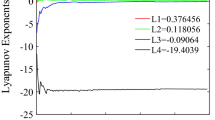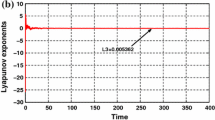Appendix A: The derivation of Theorem 1
The corresponding eigenvectors are
$$\begin{aligned} v_{1}&= \left[ \begin{array}{ c } e-ad \\ -ad\\ 0\\ 0 \end{array} \right] , v_{2}=\left[ \begin{array}{ c } 0\\ 0\\ 1\\ 0 \end{array} \right] ,\nonumber \\ v_{3}&= \left[ \begin{array}{ c } \frac{r_{1}}{2}\\ \frac{ade}{ad-e}\\ 0\\ -\frac{r_{1}}{r_{3}}\cdot \frac{ade}{ad-e} \end{array} \right] , v_{4}=\left[ \begin{array}{ c } \frac{r_{2}}{2}\\ \frac{ade}{ad-e}\\ 0\\ -\frac{r_{2}}{r_{4}}\cdot \frac{ade}{ad-e} \end{array} \right] , \end{aligned}$$
(18)
where \(r_{1}=e-a-d+\Delta ,r_{2}=e-a-d-\Delta ,\)
\(r_{3}=d-e-a+\Delta \) and \(r_{4}=d-e-a-\Delta .\)
According to [28], let
$$\begin{aligned} b=\varepsilon +\frac{ade}{ad-e} \end{aligned}$$
(19)
and \(T=[v_{1},v_{2},v_{3},v_{4}].\) Now, consider the transformation
$$\begin{aligned} (x,y,z,w)^{T}=T(x_{1},x_{2},x_{3},x_{4})^{T}. \end{aligned}$$
(20)
Apply (19) and (20) to transform system (1) into
$$\begin{aligned} \left[ \begin{array}{c} \dot{x}_{1}\\ \dot{x}_{2}\\ \dot{x}_{3}\\ \dot{x}_{4} \end{array} \right]&= \left[ \begin{array}{cccc} 0 &{}\quad 0 &{}\quad 0 &{}\quad 0 \\ 0 &{}\quad -c &{}\quad 0 &{}\quad 0 \\ 0 &{}\quad 0 &{}\quad \frac{-(a+d+e)+\Delta }{2} &{}\quad 0 \\ 0 &{}\quad 0 &{}\quad 0 &{}\quad \frac{-(a+d+e)-\Delta }{2} \end{array} \right] \nonumber \\&\times \left[ \begin{array}{c} x_{1}\\ x_{2}\\ x_{3}\\ x_{4} \end{array} \right] + \left[ \begin{array}{c} g_{1}\\ g_{2}\\ g_{3}\\ g_{4} \end{array} \right] ,\\ \dot{\varepsilon }&= 0 \nonumber , \end{aligned}$$
(21)
where
$$\begin{aligned} g_{1}&= \frac{1}{(a+e+d)^{2}-\Delta ^{2}}\left( (ad-e)x_{1}x_{2}\right. \\&\left. \quad -\,\frac{r_{1}}{2}x_{2}x_{3}-\frac{r_{2}}{2}x_{2}x_{4} +(ad-e)x_{1}\varepsilon \right. \\&\left. \quad -\,\frac{r_{1}}{2} x_{3} \varepsilon -\frac{r_{2}}{2}x_{4}\varepsilon \right) ,\\ g_{2}&= ad\left( (e-ad)x_{1}^{2}+\left( e+\frac{r_{1}}{2}\right) x_{1} x_{3}+ex_{1}x_{4}\right. \\&\left. \quad -\,\frac{er_{1}}{2(ad-e)}x_{3}^{2} -\frac{e(r_{1}+r_{2})}{2(ad-e)}x_{3}x_{4}+\frac{r_{2}}{2}x_{1}x_{4}\right. \\&\left. \quad -\,\frac{er_{2}}{2(ad-e)}x_{4}^{2}\right) ,\\ g_{3}&= \frac{(e-ad)(4de-r_{2}r_{4})r_{3}}{2ade\cdot \Delta ((a+d+e)^{2} -\Delta ^{2})}\left( (ad-e)x_{1}x_{2}\right. \\&\left. \quad -\,\frac{r_{1}}{2}x_{2}x_{3}-\frac{r_{2}}{2}x_{2}x_{4}\right. \\&\left. \quad +\,(ad-e)x_{1}\varepsilon -\frac{r_{1}}{2} x_{3} \varepsilon -\frac{r_{2}}{2}x_{4}\varepsilon \right) ,\\ g_{4}&= \frac{(ad-e)(4de-r_{1}r_{3})r_{4}}{2ade\cdot \Delta ((a+d+e)^{2}-\Delta ^{2})}\left( (ad-e)x_{1}x_{2}\right. \\&\left. \quad -\,\frac{r_{1}}{2}x_{2}x_{3}-\frac{r_{2}}{2}x_{2}x_{4} +(ad-e)x_{1}\varepsilon \right. \\&\left. \quad -\,\frac{r_{1}}{2} x_{3}\varepsilon - \frac{r_{2}}{2}x_{4}\varepsilon \right) . \end{aligned}$$
From the center manifold theory, there exists a center manifold for Eq. (21), which can be expressed locally as the following set through the variables \(x_{1}\) and \(\varepsilon \) [28]:
$$\begin{aligned} W^{c}(0)&= \left\{ (x_{1},x_{2},x_{3},x_{4},\varepsilon )\in R^{5}\mid x_{2}=h_{1}(x_{1},\varepsilon ),\right. \nonumber \\&\left. x_{3}=h_{2}(x_{1},\varepsilon ),x_{4}=h_{3}(x_{1},\varepsilon ),|x_{1}|<\delta ,\right. \nonumber \\&|\varepsilon |<\bar{\delta }, h_{i}(0,0)=0,Dh_{i}(0,0)=0,\nonumber \\&\left. i=1,2,3\right\} , \end{aligned}$$
(22)
where \(\delta \) and \(\bar{\delta }\) are sufficiently small and \(Dh_{i}(x_{1},\varepsilon )\) is the total derivative of \(h_{i},~i=1,2,3\).
To obtain the center manifold and derive the vector field on the center manifold, assume that
$$\begin{aligned} \begin{aligned} h_{1}(x_{1},\varepsilon )&= a_{1}x_{1}^{2}+a_{2}x_{1}\varepsilon +a_{3}\varepsilon ^{2}+\mathcal {O}(3),\\ h_{2}(x_{1},\varepsilon )&= b_{1}x_{1}^{2}+b_{2}x_{1}\varepsilon +b_{3}\varepsilon ^{2}+\mathcal {O}(3),\\ h_{3}(x_{1},\varepsilon )&= c_{1}x_{1}^{2}+c_{2}x_{1}\varepsilon +c_{3}\varepsilon ^{2}+\mathcal {O}(3), \end{aligned} \end{aligned}$$
(23)
where \(\mathcal {O}(3)\) includes the third-order terms (such as \(x_{1}^{3}\), \(x_{1}^{2}\varepsilon \), \(x_{1}\varepsilon ^{2}\), \(\varepsilon ^{3}\) and higher-order terms (such as \(x_{1}^{4}\), \(x_{1}^{3}\varepsilon \), etc.). Since \(\dot{\varepsilon }\equiv 0,\) the invariant center manifold should satisfy
$$\begin{aligned} \mathcal {N}(h(x_{1},\varepsilon ))\mathop {=}\limits ^{\triangle }D_{x_{1}}h\cdot g_{1}-Bh-g\equiv 0, \end{aligned}$$
(24)
where
$$\begin{aligned}&h(x_{1},\varepsilon )=\left[ \begin{array}{c} h_{1}\\ h_{2}\\ h_{3} \end{array}\right] , D_{x_{1}}h=\left[ \begin{array}{c} \frac{\partial h_{1}}{\partial x_{1}}\\ \frac{\partial h_{2}}{\partial x_{1}}\\ \frac{\partial h_{3}}{\partial x_{1}} \end{array}\right] , g=\left[ \begin{array}{c} g_{2}\\ g_{3}\\ g_{4} \end{array}\right] ,\\&B=\left[ \begin{array}{ccc} -c&{}\quad 0&{}\quad 0\\ 0&{}\quad \frac{-(a+d+e)+\Delta }{2}&{}\quad 0\\ 0&{}\quad 0&{}\quad \frac{-(a+d+e)-\Delta }{2} \end{array}\right] , \end{aligned}$$
in which \(D_{x_{1}}h\) is the partial derivative of \(h(x_{1},\varepsilon )\) with respect to \(x_{1}\).
Substituting (23) into (24), comparing and balancing the coefficients of the similar terms, one gets
$$\begin{aligned}&x_{1}^{2}:a_{1}=\frac{ad(e-ad)}{c}, b_{1}=0, c_{1}=0,\\&x_{1}\varepsilon :a_{2}=0,\\&b_{2}=\frac{(ad-e)^{2}(4de-r_{2}r_{4})r_{3}}{2ade\cdot \Delta ((a+d+e)^{2}-\Delta ^{2})\lambda _{3}},\\&c_{2}=\frac{(ad-e)^{2}(r_{1}r_{2}-4de)r_{4}}{2ade\cdot \Delta ((a+d+e)^{2}-\Delta ^{2})\lambda _{4}},\\&\varepsilon ^{2}: a_{3}=0, b_{3}=0, c_{3}=0. \end{aligned}$$
Then, Eq. (23) is rewritten as
$$\begin{aligned} x_{2}&= h_{1}(x_{1},\varepsilon )=a_{1}x_{1}^{2}+ \mathcal {O}(3)\nonumber \\&= \frac{ad(e-ad)}{c}x_{1}^{2}+\mathcal {O}(3),\nonumber \\ x_{3}&= h_{2}(x_{1},\varepsilon )=b_{2}x_{1}\varepsilon +\mathcal {O}(3)\nonumber \\&= \frac{(ad-e)^{2}(4de-r_{2}r_{4})r_{3}}{2ade\cdot \Delta ((a+d+e)^{2} -\Delta ^{2})\lambda _{3}}x_{1}\varepsilon +\mathcal {O}(3),\nonumber \\ x_{4}&= h_{3}(x_{1},\varepsilon )=c_{2}x_{1}\varepsilon +\mathcal {O}(3)\nonumber \\&= \frac{(ad-e)^{2}(r_{1}r_{2}-4de)r_{4}}{2ade\cdot \Delta ((a+d+e)^{2} -\Delta ^{2})\lambda _{4}}x_{1}\varepsilon +\mathcal {O}(3).\nonumber \\ \end{aligned}$$
(25)
Applying (25) into \(g_{1}\) of (21) and reducing the vector field to the center manifold, one obtain
$$\begin{aligned}&\dot{x_{1}}=F(x_{1},\varepsilon )+\mathcal {O}(4),\nonumber \\&\dot{\varepsilon }=0, \end{aligned}$$
(26)
where \(F(x_{1},\varepsilon )=\frac{2(ad-e)\varepsilon -(r_{1}b_{2}+r_{2}c_{2}) \varepsilon ^{2}}{2((a+d+e)^{2}-\Delta ^{2})} x_{1}+\frac{2a_{1}(ad-e)-a_{1}(r_{1}b_{2}+r_{2}c_{2}) \varepsilon }{2((a+d+e)^{2}-\Delta ^{2})}x_{1}^{3}.\)
By the bifurcation theory of equilibrium points [28], it can be easily verified that the following conditions are satisfied, for the equilibrium point \((x_{1},\varepsilon )=(0,0)\) of (26) to undergo a pitchfork bifurcation at \(\varepsilon =0\):
$$\begin{aligned}&F(0,0)=0,~~\left. \frac{\partial F}{\partial x_{1}}\right| _{(0,0)}=0, ~~\left. \frac{\partial F}{\partial \varepsilon }\right| _{(0,0)}=0,\\&\left. \frac{\partial ^{2} F}{\partial x_{1}^{2}}\right| _{(0,0)}=0,\\&\left. \frac{\partial ^{2} F}{\partial x_{1}\partial \varepsilon }\right| _{(0,0)} =\frac{ad-e}{(a+d+e)^{2}-\Delta ^{2}}\ne 0,\\&\left. \frac{\partial ^{3} F}{\partial x_{1}^{3}}\right| _{(0,0)}=\frac{a_{1}(ad-e)}{(a+d+e)^{2}-\Delta ^{2}}\ne 0. \end{aligned}$$
Consequently, Theorem 1 is obtained.
Appendix B: The derivation of \(\Lambda _1\)
Here, still utilize the center manifold theory [28]. One can transform the Jacobian matrix in Eq. (2) to the standard form using the same approach in Sect. 3.1. Let
$$\begin{aligned} \left[ \begin{array}{ c } x\\ y\\ z\\ w \end{array} \right] \!=\!\left[ \begin{array}{ c c c c } -d &{} \omega _{0} &{} 0 &{} a+e \\ \frac{-b_{0}(\omega _{0}^{2}+ed)}{e^{2}+\omega _{0}^{2}}&{} \frac{b_{0}(e-d)\omega _{0}}{e^{2}+\omega _{0}^{2}} &{} 0 &{} \frac{-b_{0}(a+e)}{a+d} \\ 0 &{} 0 &{} 1 &{} 0 \\ b_{0} &{} 0 &{} 0 &{} b_{0} \end{array} \right] \! \left[ \begin{array}{ c } y_{1}\\ y_{2}\\ y_{3}\\ y_{4} \end{array} \right] \!,\nonumber \\ \end{aligned}$$
(27)
thus, system (1) can be rewritten as
$$\begin{aligned} \left[ \begin{array}{ c } \dot{y}_{1}\\ \dot{y}_{2}\\ \dot{y}_{3}\\ \dot{y}_{4} \end{array} \right]&= \left[ \begin{array}{ c c c c } 0 &{} -\omega _{0} &{} 0 &{} 0 \\ \omega _{0} &{}0 &{} 0 &{} 0 \\ 0 &{} 0 &{} -c &{} 0 \\ 0 &{} 0 &{} 0 &{} -(a+d+e) \end{array} \right] \left[ \begin{array}{ c } y_{1}\\ y_{2}\\ y_{3}\\ y_{4} \end{array} \right] \nonumber \\&\quad + \left[ \begin{array}{ c } f_{1}\\ f_{2}\\ f_{3}\\ f_{4} \end{array} \right] , \end{aligned}$$
(28)
where
$$\begin{aligned} f_{1}&= \frac{(e-d)(e^{2}+ea+ed+a^{2}+\omega _{0}^{2}+ad)}{\gamma b_{0}}\nonumber \\&(dy_{1}y_{3}-\omega _{0}y_{2}y_{3}-(a+e)y_{3}y_{4}),\nonumber \\ f_{2}&= \frac{(d-e)(ae^{2}+ea^{2}+ead-d\omega ^{2})}{\gamma b_{0}\omega _{0}}\nonumber \\&(dy_{1}y_{3}-\omega _{0}y_{2}y_{3}-(a+e)y_{3}y_{4}),\nonumber \\ f_{3}&= -\frac{db_{0}(\omega _{0}^{2}+ed)}{e^{2}+\omega _{0}^{2}}y_{1}^{2}-\frac{b_{0}\omega _{0}^{2}(e-d)}{e^{2}+\omega _{0}^{2}}y_{2}^{2}\nonumber \\&\quad +\,\frac{(a+e)^{2}}{a+d}y_{4}^{2}+\frac{b_{0} \omega _{0}(2ed-d^{2}+\omega _{0}^{2})}{e^{2}+\omega _{0}^{2}}y_{1}y_{2}\nonumber \\&\quad -\,\frac{b_{0}(a+e)(de^{2}-a\omega _{0}^{2}-aed-ed^{2})}{(a+d)(e^{2}+\omega _{0}^{2})}y_{1}y_{4}\nonumber \\&\quad +\,\frac{b_{0}\omega _{0}(a+e)(ea+ed-ad-d^{2}-e^{2}- \omega _{0}^{2})}{(a+d)(e^{2}+\omega _{0}^{2})}y_{2}y_{4},\nonumber \\ f_{4}&= \frac{(a+d)(e^{2}-d^{2})}{\gamma b_{0}}(dy_{1}y_{3}-\omega _{0}y_{2}y_{3}-(a+e)y_{3}y_{4}),\nonumber \\ \gamma&= (e-d)(e^{2}+2ea+2ed+d^{2}+\,\omega _{0}^{2}+a^{2}+2da).\nonumber \\ \end{aligned}$$
(29)
Based on the center manifold theory, there exists a center manifold for Eq. (28), which can be expressed locally as following set over the \(y_1\) and \(y_2\) variables, i.e.,
$$\begin{aligned}&W_{c}(0)=\{(y_{1},y_{2},y_{3},y_{4})\in R^{4}\mid y_{3}=h^{1}(y_{1},y_{2}),\nonumber \\&\quad y_{4}=h^{2}(y_{1},y_{2}),|y_{1}|<\delta ,|y_{2}|<\bar{\delta }, h^{i}(0,0)\nonumber \\&\quad =0,Dh^{i}(0,0)=0,i=1,2\}, \end{aligned}$$
(30)
where \(\delta \) and \(\bar{\delta }\) are sufficiently small and \(Dh^{i}(y_{1},y_{2})\) is the total derivative of \(h^{i},~i=1,2\).
In order to compute and derive the vector field on the center manifold, assume that
$$\begin{aligned} \left. \begin{array}{lll} &{} y_{3}=h^{1}(y_{1}, y_{2})=d_{1}y_{1}^{2}+d_{2}y_{1}y_{2}+d_{3}y_{2}^{2} +\mathcal {O}(3),\\ &{} y_{4}=h^{2}(y_{1}, y_{2})\\ &{}\quad \;\,=e_{1}y_{1}^{2}+e_{2}y_{1}y_{2}+e_{3}y_{2}^{2}+e_{4}y_{1}^{3} +e_{5}y_{1}^{2}y_{2}\\ &{} \quad \qquad + \,e_{6}y_{1}y_{2}^{2}+e_{7}y_{2}^{3}+\mathcal {O}(4). \end{array} \right. \end{aligned}$$
(31)
After a more tedious approximate computation like that in Sect. 3.1, one gets
$$\begin{aligned} d_{1}&= -\frac{b_{0}}{c} \cdot \frac{2ecd\omega _{0}^{2}-cd^{2} \omega _{0}^{2}+2ed^{2}\omega _{0}^{2} +c\omega _{0}^{4}+2e\omega _{0}^{4}+dc^{2} \omega _{0}^{2}+ed^{2}c^{2}}{(e^{2}+\omega _{0}^{2})(4\omega _{0}^{2}+c^{2})},\nonumber \\ d_{2}&= \frac{b_{0}\omega _{0}(2ecd-cd^{2}-2ed^{2}+c \omega _{0}^{2}+2e\omega _{0}^{2}-4d\omega _{0}^{2})}{(e^{2}+\omega _{0}^{2})(4\omega _{0}^{2}+c^{2})},\nonumber \\ d_{3}&= \frac{b_{0}\omega _{0}^{2}}{c}\cdot \frac{2ecd-cd^{2}-2ed^{2}+c \omega _{0}^{2}-2e\omega _{0}^{2}+dc^{2}-ec^{2}}{(e^{2}+\omega _{0}^{2})(4\omega _{0}^{2}+c^{2})},\nonumber \\ d_{4}&= d_{5}=d_{6}=d_{7}=0,\nonumber \\ e_{1}&= e_{2}=e_{3}=0,\nonumber \\ e_{4}&= \frac{(a+d)(e^{2}-d^{2})}{\gamma b_{0}}\nonumber \\&\quad \cdot \frac{d_{1}d(a+d+e)^{3}+(\omega _{0}^{2}d_{1}- \omega _{0}d_{2}d)(a+d+e)^{2}+\omega _{0}^{2}(7d_{1}d-2d_{2}+2 d_{3}d)(a+d+e)+3 \omega _{0}^{2}(\omega _{0}^{2}d_{1}+2\omega _{0}^{2}d_{3}-dd_{2})}{10\omega _{0}^{2}(a+d+e)^{2}+(a+d+e)^{4}+9\omega _{0}^{4}},\nonumber \\ e_{5}&= \frac{(a+d)(e^{2}-d^{2})}{\gamma b_{0}}\nonumber \\&\quad \cdot \frac{(dd_{2}-\omega _{0}d_{1})(a+d+e)^{3}+ \omega _{0}(3d_{1}d+2\omega _{0}d_{2}-2dd_{3})(a+d+e)^{2} +3\omega _{0}^{2}(dd_{2}-\omega _{0}d_{1}-2 \omega _{0}d_{3})(a+d+e)+9\omega _{0}^{3}dd_{1}}{10\omega _{0}^{2}(a+d+e)^{2}+(a+d+e)^{4}+9\omega _{0}^{4}},\nonumber \\ e_{6}&= \frac{(a+d)(e^{2}-d^{2})}{\gamma b_{0}}\nonumber \\&\quad \cdot \frac{(dd_{3}-\omega _{0}d_{2})(a+d+e)^{3}+ \omega _{0}(2d_{2}d-2\omega _{0}d_{1}+3\omega _{0}d_{3})(a+d+e)^{2} +3\omega _{0}^{2}(2dd_{1}-\omega _{0}d_{2}+dd_{3})(a+d+e)+9 \omega _{0}^{4}d_{3}}{10\omega _{0}^{2}(a+d+e)^{2}+(a+d+e)^{4}+9\omega _{0}^{4}},\nonumber \\ e_{7}&= -\frac{\omega _{0}(a+d)(e^{2}-d^{2})}{\gamma b_{0}}\nonumber \\&\quad \cdot \frac{d_{3}(a+d+e)^{3}+(\omega _{0}d_{2}-d_{3}d)(a+d+e)^{2}+ \omega _{0}(7\omega _{0}d_{3}-2dd_{2}+2\omega _{0}d_{1}) (a+d+e)+3\omega _{0}^{2}(d_{2}-dd_{3}-2dd_{1})}{10\omega _{0}^{2}(a+d+e)^{2}+(a+d+e)^{4}+9\omega _{0}^{4}}. \end{aligned}$$
(32)
Then, the vector field reduced to the center manifold is obtained as following:
$$\begin{aligned} \left[ \begin{array}{ c } \dot{y}_{1}\\ \dot{y}_{2} \end{array} \right]&= \left[ \begin{array}{ c c} 0 &{}\quad -\omega _{0}\\ \omega _{0} &{}\quad 0 \end{array} \right] \left[ \begin{array}{ c } y_{1}\\ y_{2} \end{array} \right] + \left[ \begin{array}{ c } f^{1}\\ f^{2} \end{array} \right] , \end{aligned}$$
(33)
where
$$\begin{aligned} f^{1}&= f^{1}(y_{1},y_{2},h^{1}(y_{1},y_{2}),h^{2}(y_{1},y_{2})),\\ f^{2}&= f^{2}(y_{1},y_{2},h^{1}(y_{1},y_{2}),h^{2}(y_{1},y_{2})). \end{aligned}$$
So, one can calculate the index number \(\Lambda _{1}\) through the following formula:
$$\begin{aligned} \Lambda _{1}&= \frac{1}{16}\left( f^{1}_{y_{1}y_{1}y_{1}} +f^{1}_{y_{1}y_{2}y_{2}}+f^{2}_{y_{1}y_{1}y_{2}} +f^{2}_{y_{2}y_{2}y_{2}}\right) \nonumber \\&+\frac{1}{16\omega _{0}}(f^{1}_{y_{1}y_{2}} \left( f^{1}_{y_{1}y_{1}}+f^{1}_{y_{2}y_{2}}\right) \nonumber \\&\quad -\,f^{2}_{y_{1}y_{2}}(f^{2}_{y_{1}y_{1}}+f^{2}_{y_{2}y_{2}}) -f^{1}_{y_{1}y_{1}}f^{2}_{y_{1}y_{1}}+f^{1}_{y_{2}y_{2}}f^{2}_{y_{2}y_{2}})\nonumber \\&= \frac{(e^{2}+ea+ed+a^{2}+\omega _{0}^{2}+da)(3dd_{1}+dd_{3}-\omega _{0}d_{2})}{8b_{0}(e^{2}+2ea+2ed+d^{2}+\omega _{0}^{2}+a^{2}+2da)}\nonumber \\&\quad -\,\frac{(ae^{2}+ea^{2}+ead-d\omega _{0}^{2})(dd_{2}-\omega _{0}d_{1}-3\omega _{0}d_{3})}{8b_{0}\omega _{0}(e^{2}+2ea+2ed+d^{2}+\omega _{0}^{2}+a^{2}+2da)}.\nonumber \\ \end{aligned}$$
(34)
Appendix C: The proof of Theorem 3
Proof
Rewrite system (15) into the HDQADS vector form [27, 29]:
$$\begin{aligned} \dot{X}=AX+\sum _{i=1}^{4}X_{i}B_{i}X+C, \end{aligned}$$
(35)
where
$$\begin{aligned}&A= \left[ \begin{array}{cccc} -a &{}~a &{}~0 &{}~1\\ b &{}~-e &{}~0 &{}~0\\ 0 &{}~0 &{}~-c &{}~0\\ -b &{}~0 &{}~0 &{}~-d \end{array}\right] ,\\&B_{1}= \left[ \begin{array}{cccc} 0 &{}~0 &{}~0 &{}~0\\ 0 &{}~0 &{}~\frac{1}{2} &{}~0\\ 0 &{}~-\frac{1}{2} &{}~0 &{}~0\\ 0 &{}~0 &{}~-\frac{1}{2} &{}~0 \end{array}\right] , B_{2}= \left[ \begin{array}{cccc} 0 &{}~0 &{}~0 &{}~0\\ 0 &{}~0 &{}~0 &{}~0\\ -\frac{1}{2} &{}~0 &{}~0 &{}~0\\ 0 &{}~0 &{}~0 &{}~0 \end{array}\right] ,\\&B_{3}= \left[ \begin{array}{cccc} 0 &{}~0 &{}~0 &{}~0\\ \frac{1}{2} &{}~0 &{}~0 &{}~0\\ 0 &{}~0 &{}~0 &{}~0\\ -\frac{1}{2} &{}~0 &{}~0 &{}~0 \end{array}\right] ,\\&B_{4}=\mathbf {O},~C=\mathbf {0}, \end{aligned}$$
\(X=(X_{1},X_{2},X_{3},X_{4})^{T}\in R^{4}\) is the state vector, \(A=(a_{ij})_{4\times 4}\in R^{4\times 4},\)
\(B_{i}=(b_{jk}^{i})_{4\times 4}\in R^{4\times 4}\) and \(C=(c_{1},c_{2},c_{3},,c_{4})^{T}\in R^{4}.\) All elements of \(B_{1},B_{2},B_{3},B_{4}\) satisfy \(b_{ij}^{k}=b_{ik}^{j} (i,j,k=1,2,3,4).\) Let \(P=(p_{ij})_{4\times 4}, p_{ij}=p_{ji}(i,j=1,2,3,4),\)
\(u=(u_{1},u_{2},u_{3},u_{4})\). One can calculate
$$\begin{aligned}&\sum _{i=1}^{4}X_{i}X^{T}(B_{i}^{T}P+PB_{i})X\\&\quad =2X_{1}^{2}X_{3}p_{12}-2X_{1}^{2}X_{2}p_{13}-2X_{1}^{2}X_{2}p_{14}\\&\quad \quad +\,2X_{1}(X_{3}^{2}-X_{2}^{2})p_{23}-2X_{1}(X_{2}X_{4}+X_{3}^{2})p_{34}\\&\quad \quad +\,2X_{1}X_{3}X_{4}(p_{24}-p_{44})\\&\quad \quad +\,2X_{1}X_{2}X_{3}(p_{22}-p_{33}-p_{24}). \end{aligned}$$
According to Lemma 1, need
$$\begin{aligned} \sum _{i=1}^{4}X_{i}X^{T}(B_{i}^{T}P+PB_{i})X=0 \end{aligned}$$
holding for any \(X_{i}\in R\)
\((i=1,2,3,4)\). So, take
$$\begin{aligned}&p_{12}=p_{21}=p_{13}=p_{31}=p_{14}=p_{41}=p_{23}\nonumber \\&\quad =p_{32}=p_{34}=p_{43}=0,\nonumber \\&p_{24}=p_{42}=p_{44}=p_{22}-p_{33}. \end{aligned}$$
(36)
Thus, one gets
$$\begin{aligned} P&= \left[ \begin{array}{cccc} p_{11} &{}\quad 0 &{}\quad 0 &{}\quad 0\\ 0 &{}\quad p_{22}&{}\quad 0 &{}\quad p_{44}\\ 0 &{}\quad 0&{} p_{33} &{}\quad 0\\ 0 &{}\quad p_{44}&{}\quad 0 &{}\quad p_{44} \end{array}\right] ,\\ M&= uA+2C^{T}P\\&= [-u_{1}a+u_{2}b-u_{4}b,~u_{1}a-u_{2}e,~-u_{3}c,\\&u_{1}-u_{4}b],\\ \end{aligned}$$
$$\begin{aligned} Q&= A^{T}P+PA+[B_{1}^{T}u^{T},~B_{2}^{T}u^{T},~B_{3}^{T}u^{T},~B_{4}^{T}u^{T}]^{T}\\&= \left[ \begin{array}{cccc} -2ap_{11} &{}~ap_{11}+bp_{22}-bp_{44}-\frac{1}{2}u_{3} &{}~\frac{1}{2}u_{2}-\frac{1}{2}u_{4}&{}~p_{11}\\ ap_{11}+bp_{22}-bp_{44}-\frac{1}{2}u_{3} &{}-2ep_{22} &{}0 &{}-dP_{44}-eP_{44}\\ \frac{1}{2}u_{2}-\frac{1}{2}u_{4} &{}0 &{} -2cp_{33} &{}0\\ p_{11}&{} -dP_{44}-eP_{44} &{}0 &{}-2dP_{44}\\ \end{array}\right] . \end{aligned}$$
For simplifying \(Q\), take
$$\begin{aligned} u_{1}=u_{2}=u_{4}=0, u_{3}=2(ap_{11}+bp_{33}), \end{aligned}$$
so
$$\begin{aligned} u=(0,0,2(ap_{11}+bp_{33}),0). \end{aligned}$$
Now, one has
$$\begin{aligned}&P= \left[ \begin{array}{cccc} p_{11} &{}\quad 0 &{}\quad 0 &{}\quad 0\\ 0 &{}\quad p_{22}&{}\quad 0 &{}\quad p_{44}\\ 0 &{}\quad 0&{}\quad p_{33} &{}\quad 0\\ 0 &{}\quad p_{44}&{}\quad 0 &{}\quad p_{44} \end{array}\right] ,\\&M=[0,~0,~-2c(ap_{11}+bp_{33}),0],\\&Q=A^{T}P+PA+[B_{1}^{T}u^{T},~B_{2}^{T}u^{T},~B_{3}^{T}u^{T},~B_{4}^{T}u^{T}]^{T}\\&=\left[ \begin{array}{cccc} -2ap_{11} &{}~0 &{}~0&{}~p_{11}\\ 0 &{}-2ep_{22} &{}0 &{}-(d+e)P_{44}\\ 0 &{}0 &{} -2cp_{33} &{}0\\ p_{11}&{} -(d+e)P_{44} &{}0 &{}-2dP_{44}\\ \end{array}\right] \!. \end{aligned}$$
According to Lemma 1, one obtains the Lyapunov-like quadratic function
$$\begin{aligned} V(X)&= X^{T}PX+uX+\frac{1}{4}uP^{-1}u^{T}\\&= p_{11}X_{1}^{2}+p_{33}X_{2}^{2}\\&\quad +\,p_{33}\left( X_{3}+\frac{ap_{11}+bp_{33}}{p_{33}}\right) ^{2}\\&\quad +p_{44}(X_{2}+X_{4})^{2}, \end{aligned}$$
and the derivative of it along with system (1)
$$\begin{aligned} \dot{V}(X)&= X^{T}QX+MX+uC\\&= ap_{11}X_{1}^{2}+ep_{22}X_{2}^{2}+cp_{33}X_{3}^{2}+dp_{44}X_{4}^{2}\\&\quad -\,p_{11}X_{1}X_{4}+(d+e)p_{44}X_{2}X_{4}\\&\quad +\,c(ap_{11}+bp_{33})X_{3}. \end{aligned}$$
Since \(a>0,b>0,c>0,d>0,e>0,p_{ii}>0 (i=1,2,3,4)\) and
$$\begin{aligned}&p_{22}=p_{33}+p_{44},\\&-4aedp_{33}p_{44}+(ad^{2}+ae^{2}-2aed)p_{44}^{2}\\&+ep_{11}p_{33}+ep_{11}p_{44}<0, \end{aligned}$$
one gets \(P>0\) and \(Q<0\). From Lemma 1 the above conclusion holds. \(\square \)












